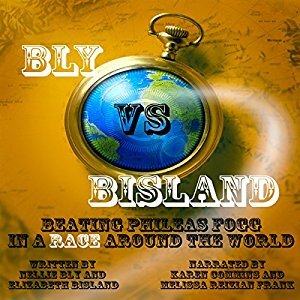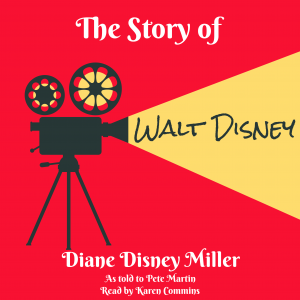Karen Commins's Blog, page 2
January 23, 2023
TDIMH – Frustration Is Temporary
I often look at my journals from the past with the thought “What happened X years ago today?”
When entries are at least 10 years old, I sometimes re-publish them here on my blog in the category of This Date in My History (TDIMH). They helped me see how far I’ve come and hopefully encouraged others along their path.
Today, I happened to wonder about my life 20 years ago. I hadn’t planned to write on my blog, but the story that day was too good to pass up.
SituationI worked 11 hours without lunch on 1/22/03 to fix an inoperable email server. At 7:50pm that evening, I wrote:
Days like today are when I hate my day job the most. I only got home within the last 10 minutes. I had barely stepped foot in the building before I knew that our email server was down. I was getting my bagel in the cafeteria — I hadn’t even gotten to my desk, much less taken off my coat…
I wore a hole in the carpet between my desk and the computer room while I attempted one tape restore after another. The damn thing finally came up just after 6pm, but now I don’t know if it’s usable.

Thursday 23 January 2003 10:35am at my desk at work
I had heated words with one of the attorneys who was worrying me to death about that stupid server. He had been sending the secretary to ask me about the progress. On her last trip, she said he asked why I hadn’t gotten help. In the sexist environment that is our office, that question is equal to saying that I am at the end of my technical expertise, and I should get a man to fix the problem.
I started to tell her my answer, but then I told her I would call him. He’s a loud, bully sort of person from NY who is probably not used to women standing up to him.
During our “conversation”, I told him that I had spent 11 hours yesterday and all morning today trying to solve this problem. I said I had asked for help, but none is forthcoming.
He said he wanted to be sure I knew the magnitude of this situation. I said I understand it better than anyone because I’m the one who has to fix it.
At one point, I told him if he could do a better job, he was welcome to come and do it.
Anyway, he got louder, and I told him that he was yelling at me. I said I am a professional person, and I don’t let people yell at me.
After a few more sentences from him, I said again that I would not listen to him yell at me. I would be glad to talk to him later if he could be calmer.
Goodbye. (Click) I hung up on him.
Hell must have frozen over twice today, and I don’t say that just because the outside temperature is 16 degrees! First, after the server was back on-line, [the attorney] actually sent an email to apologize! He said he didn’t mean to sound like he was attacking me personally.
The next line was more of an insult than an apology to me because he wanted to be sure we were doing all we could. (No, [attorney], I’m just sitting here twiddling my thumbs and not really trying to solve the problem.) He ended it with a line about being appreciative of my efforts.
To the people who kept asking me when the server would be up, I wanted to respond with 1 or a combination of these comments:
You know, if I could see the future, I’d buy winning lottery tickets so I would never have to see your a** or work on this kind of s*** again.I just added 1 hour to the time that I let you back on the system. No matter how long it takes to bring the server on line, I’m going to keep you off it for as many more hours as each time you have worried me and asked this question.I can give…and I can take away. If you ask me about this one more time, I’ll make sure you never get email again.Take your silly-a**ed problem down the hall to someone who gives a s*** about it.Take-awaysNo one has the right to verbally abuse you.
My mother used to tell my brothers and me that we shouldn’t let anyone walk all over us. After a male boss yelled and cursed at me one day, I decided that I’d never allow anyone else to treat me that way again. I found that the more I stood up for myself, the more people respected me.
Have patience with those working to solve your problem.
Whether it’s your computer network/bank/electricity/gas that isn’t working, rest assured that the people charged with fixing it really do want it to work and are doing what they can as fast as possible to restore your service. Hounding them about it being down doesn’t endear you to them or help them move any faster.
Although my story doesn’t illustrate the following points, I would add:
A little humor goes a long way in easing frustrating situations.
I admit that I lost my patience and temper with that attorney. While I’d still say he deserved it, I’ve found that humor reaps much better results!
Don’t make a life-altering decision based on a temporary condition.
I had many days when I hated the job so much I could have easily and happily quit. However, I value security, so I realized that kind of life-changing decision should be made only after careful thought and planning. Had I quit on any of those bad days, I would have hurt my finances in both the short and long terms.
These days, I barely think about my 25-year tenure in information technology unless I read one of my journals written during that period!
I still have problems to solve and frustrations in my career as an audiobook narrator, but I know they will teach me lessons if only I look for them.
Image: Travis Randolph / Flickr under Creative Commons 2.0 license
The post TDIMH – Frustration Is Temporary appeared first on Karen Commins.
January 14, 2023
Narrator’s Cup of Joe — Woo Woo Blend
When the fabulous Daniela Acitelli interviewed me in 2021 on Narrator’s Cup of Joe, her fantastic YouTube video show, we talked about a lot of different topics. She invited me on the show again in December, this time to discuss “woo woo” subjects: affirmations, visualizations, and manifestations.
Long-time readers will feel no surprise in my belief in and usage of affirmations and visualizations! Daniela and I enjoyed the sort of deep, meaningful conversation I could have all day, and I hope you like it, too.
Of course, I have additional stories and many resource links to share! I’ll add the video timecode for your reference.
6:18
In the 1990s and 2000s, I listened to Wayne Dyer’s talks and books on CD as I commuted 30 miles to and from my thrival job in downtown Atlanta.
In his book called You’ll See It When You Believe It: The Way to Your Personal Transformation, Dyer wrote about how we have to change our belief system BEFORE we get the manifestation of our dream.
I met Dr. Dyer and he signed my copy of this book at a conference 10 days after my precious daddy passed away.
I didn’t think I’d get to speak to Wayne that day. A crowd of people were circled around him after his lecture. He said he could only meet people for a few minutes as he had to catch a plane.
It seemed like the crowd parted and kind of pushed me forward until I was right there, face to face with him.
I’m surprised I could even say anything to him, given the emotions I felt.
I told Wayne that I’d just lost my dad, and it meant a lot to me to be there with him that day. He surprised me with a hug and said “no one ever dies.”
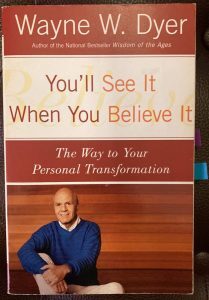
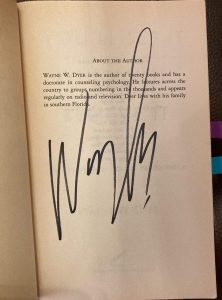
As an aside to this story, I was wearing a bracelet that day that I think picked Wayne’s polo shirt when we hugged. I felt bad about that for years.
When I told this story to a friend, they said that if my bracelet did pick Wayne’s shirt, he would probably have viewed that as evidence that his work was valuable and that he had made a real connection with me.
Two other books from Wayne Dyer that made a big impression on me were The Power of Intention: Learning to Co-Create Your World Your Way and Inspiration: Your Ultimate Calling.
On 6 April 2006, I was helping a person who had car trouble when something extraordinary and enchanting happened, as I wrote in my journal the next day:
On the ground was a magnificent butterfly, which I learned in a later Google search was an Eastern Tiger Swallowtail. I wondered if it was alive because it was so still at first. When it moved, I began to wonder if it was hurt. [I was afraid the person I was helping would step on the butterfly.] Fortunately, she didn’t.
The whole time that I watched the butterfly, I was thinking of Wayne Dyer’s story of a magical encounter with a butterfly. He talked about it in his newest book “Inspiration”, which I recently read, and on the PBS special about the same. The whole book is about living in spirit and being of service. Here I was, being of service to someone who needed it, and I had a beautiful butterfly before me as a symbol of it. After all, I was inspired to act on the impulse to help this stranger, who turned out to be my neighbor.
The wind blew and made the butterfly’s wings stand straight up. He still didn’t fly away, so I thought more that he might be hurt. Drew told me to tap his wings (his meaning the butterfly, not Drew!). I told Drew a little about Wayne Dyer getting a butterfly to sit on his finger, so Drew said to put my finger down there and see if the butterfly would jump it on like a perch.
I did…and he did!
Then the wildest thing happened — he walked all the way up my arm and looked at me!!!!
It was just like the way it happened for Wayne Dyer. I wanted to get a picture, but Drew couldn’t get one fast enough with his cell phone. Wayne Dyer thought his butterfly was his dear friend Jack. It even seemed to me that my butterfly could have been Daddy [or at least sent by him].
The reason Drew couldn’t get a picture is because, after a minute or so of being on my arm, my beautiful butterfly flew off across the street, landing in a yard. Maybe he was just tired (like me!).
 Using a picture I found on-line, I drew the butterfly in my journal.
Using a picture I found on-line, I drew the butterfly in my journal.9:29
I mentioned Louise Hay’s landmark book You Can Heal Your Life. She lists physical ailments, the thoughts that may have been behind the symptom, and new thoughts to think.
13:35
When Daniela referred to the Reticular Activation System (RAS), I was reminded of the first time I came across that phrase. Of course I read it in a book! Henriette Anne Klauser’s wonderful book Write It Down, Make It Happen describes the RAS as a:
…filtering system of the brain. Writing it down sets up the filter. Things start to appear — it’s a matter of your filtering system.
If you have never owned a Honda before, and you buy a blue Honda, all of a sudden you see blue Hondas all over town. You might wonder, Where are all these blue Hondas coming from? But they were there all along; you were just not paying attention to them.
Putting a goal in writing is like buying a blue Honda; it sets up a filter that helps you be aware of certain things in your surroundings. Writing triggers the RAS, which in turn sends a signal to the cerebral cortex: “Wake up! Pay attention! Don’t miss this detail!” Once you write down a goal, your brain will be working overtime to see you get it, and will alert you to the signs and signals that, like the blue Honda, were there all along.
I love her book because she offers different methods and examples of writing our plans and goals to give us clarity and aid our manifestations.
18:00
I talked about Louise Hay’s book Mirror Work: 21 Days to Heal Your Life. This book offers affirmations and journal prompts to help you re-connect with your true self.
20:47
I was discussing the energy you put out to the universe. If you’re obsessively thinking, feeling, saying, and writing words coming from desperation, you’re telling the Universe that’s what you expect to see mirrored back to you. I wrote about changing your mindset in my 2008 article Think/Write/Speak what you WANT into BEING!
In addition to the book linked in that article, I want to recommend Secrets of Success: The Science and Spirit of Real Prosperity by Sandra Anne Taylor. I read it in 2007 and copied these passages about obsession/desperation in my journal:
If you were to project a laser light through the hologram that is your own consciousness, what would that picture hold? What would be revealed in the front, in the middle, in the back, and all the way around? Would there be a confident image on the surface with fear hiding behind it? Would there be an exterior of optimism with an interior of doubt? If so, you need to know that the Universe sees your entire truth—every bit of it—and responds accordingly.
So if you’re visualizing meeting your perfect partner, yet a part of you thinks such a person doesn’t exist, then that consciousness of limitation overrides your specific intention and actually creates a stronger vision of lack (my emphasis).
If you’ve created the goal to attract a better job but you consistently doubt your ability to make it happen, then that failure-consciousness will move out into the Universe, projecting a dark void where no real value can come to be.
Your entire consciousness needs to be considered. You may send out intentions, treasure maps, and even prayers to make something happen, but all of that will go unanswered if it’s the only approach you take. Without a supportive consciousness, your individual desire will just float out in space, and your results will be hit-or-miss at best—or nonexistent at worst.
To get the Law of Manifestation to work the way you desire, you must consider the whole. It’s not enough to say, “If I only focus on what I want, then I’ll get it.” You need to support that intention with a positive multidimensional view of yourself. You must see yourself as capable and worthy of receiving—and perceive the world as abundant and willing to provide. You can visualize buying a winning lottery ticket all you want, but if you look in the mirror with judgment and self-doubt, your outcome will be consistently disappointing.
This is the holographic reality of manifestation: Your consciousness can’t create something that you’re not fully aware of deep within yourself. Your system of thoughts and beliefs is a driving force in the field of Universal intention, so it’s important to know that the value you seek in the external world can only come from a pervasive sense of value within.
If you’re always—or even often—focused on worry, lack, and unhappiness, then that is all that your consciousness can create for you. If you’re not aware at least on some level of the intrinsic value already within yourself and your life, it will be a constant struggle to create value in your destiny. This pit of self-negation is one of the biggest problems people face in trying to create a brilliant future.
You’ll see throughout this book that if you’re facing failure, this is usually the first place to start. Even if your self-esteem doesn’t seem all that negative, if you’re merely self-conscious or experiencing some self-doubt, or you’re just confused about your place and your power in the world, it can be enough to darken your energy and move your consciousness and your quantum psychology in a negative direction—and send out a holographic projection that attracts rejection.
35:57
I brought up Byron Katie’s book Loving What Is: Four Questions That Can Change Your Life. The 4 questions are listed in this interview with Katie, and she explains how they help you move to better thoughts.
41:38
I mentioned Mike Dooley’s courses and daily Notes from the Universe. You can view his offerings and sign up to receive the free, inspirational Notes at this link.
44:06
As I said on the Joe video, the Universe doesn’t deliver on our timetable and in the way we think things should happen. Since I used my house as an example of this statement, I thought you might like to see the house I dreamed about and the one I have.
I don’t remember when my dream of a Queen Anne Victorian house took root. I think even as a teenager I had pored over numerous books showing magnificent Victorian houses and subscribed to magazines devoted to Victorian homes. Starting on 11 May 2003, I began writing a house journal to describe my dream Victorian. As I came across or thought of aspects I wanted in my house, I added them to the journal.
My idealized house is pictured below. I affixed this picture to the tack board in my cubical for years during my IRS tenure so I would see it every day at work.

This second picture is my modern Victorian house, where we moved in 2018. It’s not the house I was dreaming of, but it is my dream house and better than I imagined in so many ways!

You’ll note that the architecture met my broad brush strokes with the turret and sharply pointed roofline, but this house was built in 2012 and has a spacious, modern floorplan, plenty of storage, central HVAC, and electrical and plumbing systems that are up to code! If you want to see the interior of the main floor turret room, head over to my Harp Videos page. My recording studio is downstairs in the back corner on the driveway side and is shown on my About Me page.
We replaced the front door with one that has a Victorian vibe. It looks like a vintage iron door but was made with materials to withstand temperature changes. We also recently painted the keystones and bricks over the windows to accent that feature. In addition, we painted the ceilings over the front stoop and back patio using the color that Southern Living called the perfect “haint blue”.


So, you see, even though the Universe didn’t deliver all the exterior details that I’d imagined, we’ve been able to make modifications to accentuate the Victorian characteristics. My HOA most assuredly would deny my desire for a “Painted Lady” color scheme, but I’m planning to request approval to make some minor changes to the façade, including adding some gingerbread in the gables. We’ve enhanced the Victorian charm inside with ceiling medallions and our lighting and decorating choices.
62:09
Daniela asked me about my harp. The 5 points I discussed in my article Resonance between harp and voice-over are still true for narrators today.
When I bought a flute in 2017, I wrote The Still Small Voice. Audiobook narrators will find it an encouraging story to follow their own inner promptings.
I recently published the article My Life as a Musician, which includes a number of resource links that other musicians may find useful.
75:09
As I chatted about writing in my journal, I was asked about the type of pen I use. I actually NAMED the Taccia Paris Lilac fountain pen for the company! I told the story and showed the picture of it in this article.
Like I said at the beginning of this article, I love discussing these kinds of topics! I’d love to continue the conversation in the comments, so please let me know your thoughts!
The post Narrator’s Cup of Joe — Woo Woo Blend appeared first on Karen Commins.
January 1, 2023
Embracing Life and Work
When I was young, I had this poster or similar ones taped on my bedroom wall.
Embed from Getty Imageswindow.gie=window.gie||function(c){(gie.q=gie.q||[]).push(c)};gie(function(){gie.widgets.load({id:'MYmqxF1qReVBF5mwXuVP_g',sig:'Dut9trSzGDcb31LDuulTjtwiv5SZdxisKUdAwaq3-2A=',w:'483px',h:'594px',items:'93404730',caption: true ,tld:'com',is360: false })});You probably recognize David Cassidy from his work on The Partridge Family TV show.
I adored David when I was young, and I learned a valuable lesson from him as an adult.
In the 1970s, David Cassidy was one of the biggest stars on the planet. He seemed to have it all: talent, looks, charm, money, opportunities as a singer and actor, and legions of fans, including me.
Somewhere during the years, he decided his outsized life wasn’t enough, and things went horribly wrong for him.
In June 2018, we watched the documentary David Cassidy: The Last Session. I was sad to see him looking so bad, as much of it was filmed 2 months before he passed on 21 November 2017.
The clips of him in his 70s heyday were incredible because of the 1000s and 1000s and 1000s of screaming fans.
However, rather than feeling grateful for the adoration of so many people and enjoying that life, he seemed dismissive of it. He said he never wanted to be a teen idol, and he felt frustrated that he couldn’t play the type of hard rock music that he wanted to.
David couldn’t accept that the ROCK market didn’t want him to sing, but the POP market did. Or perhaps he would have found an audience who liked him as a rocker. I don’t know that he tried. This article has a good sampling of David’s comments.
I’m sure it was very difficult to be in the “hurricane of success”, as Barry Manilow calls it, especially for someone so young.
The documentary included a phone call from him where he admitted that he had lied about his drinking and really had no sign of dementia. He said his liver disease was from alcohol poisoning, and he “did it all to myself”. He said he drank to fill the emptiness.
I remembered reading David’s memoir years ago and thinking that he was very bitter.
I could relate to David’s feeling unfulfilled by his work. I spent YEARS working at the IRS feeling extremely frustrated and wishing that I wasn’t there and was instead doing voiceover work full-time. However, I did appreciate that my IRS career gave me financial security and healthcare options I wouldn’t have had as a freelancer.
When I acted like David and bemoaned what I thought I lacked, that lack continued to show up for me. It caused me to feel very unhappy in the present moment. I didn’t realize back then that such thoughts are an act of self-negation.
Acceptance Is KeyI wish I could somehow convey what a difference ACCEPTANCE made to me!!
It started with me saying out loud and with true feeling “I ACCEPT MY LIFE!” It seems like such a small thing to say and do, but it made such a tremendous difference. EVERYTHING changed at that point. The desperation I felt for my situation to change vanished and was replaced by enthusiasm for the work I was doing.
I wrote in my journal on 12 August 2008:
I ACCEPT MY LIFE!
I realize at long last that I have been blocking things from coming to me with my resistance to my day job. I read about these things in books, yet I never saw myself or my actions mirrored there. Today, p.43 of Secrets of Success has much more meaning to me:
Your emotional broadcast must align with your specific goals if you want to achieve real results…The irony is that attaching our joy to something in the future actually sabotages our ability to be content now. And according to the laws of intention, it greatly reduces our potential to attract the very things we’re pinning our hopes on. The solution comes from choosing to live now in the happy energy that we want to create.
Accepting my life is a huge relief. I no longer have to pretend to be something else. I can feel happier in the present moment knowing that I am where I am supposed to be. I have said the words many times, but I had feelings of doubt. I always felt like I should be doing something else. If I had free time at work, I felt like I needed to be working on voiceover goals, but doing so made me feel guilty.
[My best friend] said she could see for years that my resistance to my reality was blocking me from receiving. She said I had put up walls and was only looking for things to come to me a certain way.
I know that acceptance of my very wonderful life is not dependent on getting a particular job, either at the IRS or in voiceover. Accepting my life means I can be like water, flowing smoothly and easily on my life’s path.
As soon as I accepted my life AS IT WAS, things started to flow better in both the thrival job at the IRS and in my voiceover business.
Declaring that you accept your life is not saying you’re accepting that your dream won’t happen. Instead, you’re telling the Universe that you accept how things are RIGHT NOW and that you know your dream (or something better!) will materialize in its own good time without your need to stress, push, and force the result you want into being.
All of the metaphysical teachers stress that we can focus on what we want with the calm assurance that we free the Universe to provide it or SOMETHING BETTER to us at the right time. Otherwise, you may find yourself feeling increasingly desperate for your desired outcome, which activates the Law of Paradoxical Intent and pushes your hoped-for outcome further away.
Acceptance led me to embrace my work, both at the IRS and since then.
David Cassidy’s story continues to be a powerful reminder to me to be grateful for my life and not spend my time and energy discounting it and desperately wishing it were the exact way I envisioned it. However, we can do things that make our lives even more rewarding and meaningful.
Redefining WorkIn 2018, as I was starting to develop NarratorsRoadmap.com, I wrote in my journal about reading the article How to Do the Work Only You Can Do by Jeff Goins. Goins interviewed former astronaut Alan Bean, who later documented his space flights by painting what he had seen. I tweeted the article on 6/20/18, commenting “I love this inspirational story! I’m realizing more and more that work I feel called to do and things that I want to create aren’t necessarily what I and other people would think of as my career.”
I hope you’ll read the article, but I wanted to highlight some important passages from it:
Your life’s work is rarely what you expect it to be….Alan had to paint the moon because no one else could — at least not like him.
…we all have something like that, something only we can do. You may call it a purpose or a calling or your life’s work, but you are here to do important work. And sometimes, you have to leave your comfort zone to do it.
[Bean] began experimenting with ways to make money off his art. But how could he earn enough to provide for himself and his family when he kept comparing himself to the likes of Monet and Picasso?
We all do this: we question the work we do and compare it to what someone else is doing. But that’s their duty, not ours. And they have the authority and advantage over us because that’s THEIR work.
…to do your duty, the work that only you can do. You can’t compare yourself to others and keep trying to measure up to someone else’s standard. To do what no one else can do, you have to use what no one else has.
Which is to say, the tools and skills and experiences that make you uniquely you are incredible advantages over the competition.
As an audiobook narrator, I’ve often been snared in the trap of comparison-itis and have done the inner work needed to usually be free of it. (If you’re interested, NarratorsRoadmap.com members can watch a video where I shared my “Antidotes for Comparison-itis and Bad Review Fever”.)
For years, I waited for certain things to happen through my work as a narrator, yet they’ve appeared for me as a result of creating my site. While they didn’t look like I envisioned or come from the direction I expected, I’ve learned to count all my blessings regardless of how and when they show up for me.
As we start a new year, my goals are simply to continue accepting my life and embracing the work that is mine to do.
To that end, I am excited to announce I’m starting something new on 18 January: the Narrators Roadmap Club on Clubhouse! Every other Wednesday, I’ll host the Pit Stop room, which is your fortnightly mid-week rest area to refuel your drive. My friend and co-host Anne Flosnik and I will talk with narrators who have careers beyond narrating. I invite you to join the Narrators Roadmap club to be notified about upcoming discussions, and I hope I’ll see you in the Pit Stop!
The post Embracing Life and Work appeared first on Karen Commins.
December 13, 2022
The Story Behind the Story Part 2: Music
Today’s World Violin Day! As you know, I play harp, not violin. However, a violinist and his instrument figured prominently in my audiobook of FANNY HERSELF: A PASSIONATE INSTINCT by Edna Ferber and in the music I chose to go under the credits.
I started to write this quick story as a Twitter thread, but I strive to keep my original content on MY site and share it on social media.
On Tuesday 3 June 2014, I wrote in my journal:
The recording of FANNY HERSELF [by Edna Ferber] is done! Yay!
I had been thinking…of how to change the title to make the book different from the free edition…I want to retain the original title but add something to it to differentiate it [due to Kindle rules for publishing public domain books.]
The Audioblocks site [now Storyblocks.com] lets you search by instrument, mood, and time in addition to genre…I knew I wanted something with a violin solo since Fanny’s brother Theodore was a child prodigy violinist. She and her mother had to do without almost everything in order to pay for his studies overseas. He doesn’t even have a lot of lines in dialogue, yet you always know about Fanny’s brother.
I found a piece that sounds like a clock ticking and machinery before a violin solo of a contrasting tune emerges. It has a tension that suddenly resolves, just like the end of the book! I really liked it on the first listen and declared it perfect on the second one when Drew listened and liked it, too. The music was named “Passionate Instinct”.
And “Passionate Instinct” is now part of my ebook’s title — FANNY HERSELF: A PASSIONATE INSTINCT. Drew and I both think it sort of describes the book.
Not only did I write all of that in my journal, but I also wrote this 2014 article about finding and using M. Leone Bracker’s hand-drawn illustrations from 1917 in my ebook.
I looked at the illustrations this morning, and sure enough, I found one of Theodore playing violin for his teacher.
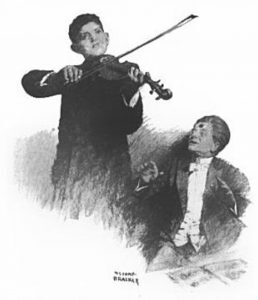
You can hear the haunting violin music I selected for the credits below.
Opening credits (Note that book was in the public domain when I recorded it. I would now say “The text is in the public domain” instead of the details I gave about the original publication.)
00a_Fanny - Opening creditsMP3jPLAYLISTS.inline_0 = [ { name: "00a_Fanny - Opening credits", formats: ["mp3"], mp3: "aHR0cHM6Ly93d3cua2FyZW5jb21taW5zLmNvbS93cC1jb250ZW50L3VwbG9hZHMvMjAyMi8xMi8wMGFfRmFubnktT3BlbmluZy1jcmVkaXRzLm1wMw==", counterpart:"", artist: "", image: "", imgurl: "" }];MP3jPLAYERS[0] = { list: MP3jPLAYLISTS.inline_0, tr:0, type:'single', lstate:'', loop:false, play_txt:' ', pause_txt:' ', pp_title:'', autoplay:false, download:false, vol:100, height:'' };
Closing credits
The post The Story Behind the Story Part 2: Music appeared first on Karen Commins.
November 16, 2022
How to Download Clubhouse Replays
I’ve recently enjoyed participating in several Clubhouse chats. In fact, I held an Ask Me Anything on the site on 9/16/22 to celebrate the 3rd anniversary of NarratorsRoadmap.com.
If you click the link above, you’ll see it goes to an Evernote page that has the Clubhouse graphic and audio recording of the chat, as well as an AI-generated transcript from Sonix.ai. (Please see the additional comments about the transcript in the notes below.)
When creating an open Clubhouse room, Replays are ON by default. The Replay is created automatically once you open the room and will be available on Clubhouse until you delete it. Replays let your audience hear the discussion at a later time, share the link to the chat on and off Clubhouse, skip to the next speaker, and make 30-second clips.
Just as — perhaps even more — importantly, Replays can be re-purposed in other ways, such as in part or whole on other social media sites. You know I LOVE to re-purpose content! For instance, I could transcribe one or more recordings and copy my words to a blog article. I’m also extracting clips to make audiograms to promote the replay in between live events.
As it turns out, I accidentally deleted my AMA event from Clubhouse, so it was a good thing I had downloaded the Replay! For those who are interested, the 15% discount I offered to new members of my site is still valid!
I found that downloading the Replay wasn’t as straightforward a process as I would like. After another narrator who ran a Clubhouse room was unable to download the audio, I decided to create this 4:49 video to show the steps.
Notes:
1) I have an iPhone. The screens and steps on an Android phone might be somewhat different.
2) If you have an iPhone and an Apple computer, you can use AirDrop to “magically” copy the file from your phone, assuming you have the right version and are within Bluetooth and Wi-Fi range. It’s even faster and easier than the email solution that I showed, but I said email is easiest because everyone can do it. You’ll find Airdrop instructions here.
3) My video beta tester said the last page they Googled appeared at 3:01 in the video, where the NarratorsRoadmap.com page is shown in my background. As I wrote in a screen annotation at 2:51, you’re in Safari at this point. Therefore, the last site you visited will appear on your screen.
4) My video beta tester also reported that the download arrow discussed at 3:05 in the video appeared at the bottom of the screen rather than the top. Apple moved the Safari URL tab bar to the bottom of the screen when they released iOS 15. You can move it back to the top of the screen to match my orientation by using these instructions.
5) For some reason I haven’t discovered, the Replay is an MP4 file, which is a video format. I used Camtasia to convert it to an MP3 file. Pro Tools also would convert it, but it was taking too much time.
6) Here’s my affiliate link to Sonix.ai as we both get free minutes if you sign up for the service. I use Sonix a lot to transcribe podcasts and YouTube videos where I want the info but don’t have time to listen and take notes. Sonix doesn’t write the words with 100% accuracy, but the 80% or more (usually 90-95%) that it gets right is enough for me to understand the gist of what was said. If parts of the transcription don’t make sense, the audio is cued with the text, so it’s easy to hear a certain segment. Sonix also doesn’t necessarily include the proper punctuation on the transcript.
7) I’ve started a Clubhouse club named Narrators Roadmap and invite you to join! You don’t need to be a member of the NarratorsRoadmap.com site. This room is open to everyone! Beginning in January 2023, I’ll start the Pit Stop room — your fortnightly mid-week rest area to refuel your drive! I’ll talk with audiobook narrators who have at least 1 other profession. They’ll inspire us to use all of our talents and gifts!
The post How to Download Clubhouse Replays appeared first on Karen Commins.
October 18, 2022
Much More Than “Just Reading”
An author wrote to me this week because her publisher sent her a list of items to be done before they could produce the audiobook. She wanted to know if these requests were typical. She complained that the publisher is only uploading the audiobook files and taking her royalties, but she had to design the cover and market the audiobook. She concluded, “I feel I’m doing all the work for someone to just read my book out loud.”
I’ll answer her question, but, more importantly, I also want to address the erroneous statement that the narrator is “just reading the book out loud.”
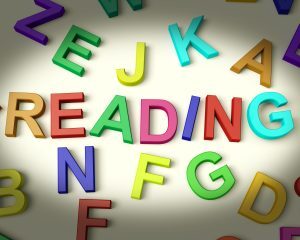
Narrators following industry best practices read the entire book before recording the first word of it. We make extensive notes about characters and pronunciations.
This article and this one discuss my preparation and audiobook prep in general, respectively. I don’t mark pauses or emphasis, preferring to make those choices organically while performing the text.
During my prep of fiction books, I look for clues about the characters or people in the book, including:
their agetheir socioeconomic standingtheir native region and/or specified accenttheir physical traits and attributesWith this info, I can develop a convincing voice for each character based on the author’s clues and present the characters as real people in real circumstances, not a caricature in a cartoon. If the character has an accent, I may need to learn it.
In non-fiction books, I research the author and the content of the book so that I understand the subject and message to be conveyed. I’m standing in for the author when recording the book, and I want to speak with her passion and authority.
In either case, I’ve done copious research on correct pronunciations. Anyone who has ever heard a GPS mispronounce the name of their town will be annoyed to hear mispronounciations in an audiobook. Mispronunciations take the listener out of the story.
I don’t know the type of material the publisher requested from this author. The goal of the publisher and narrator is always to realize the author’s vision of the book, so it’s perfectly reasonable to ask the author to supply additional info to aid in achieving that goal.
I am confident that no one is asking the author to do extra work. Instead, the publisher and narrator are trying to understand her preferences so they can interpret and deliver them in the audiobook performance.
For instance, authors of fiction books are commonly called on to submit character lists. While the narrator does take notes during the pre-read, we may miss details. We’d love to see the author’s description of each character to include any personality quirks and back story affecting the character’s POV.
It’s also very helpful to hear from the author about things that ARE NOT in the book, like:
whether the book is part of a series with recurring characterswhom the author would cast in each role if they were producing the movie versionif any pronunciations are made up, not easily researched (such as names of private citizens), or are preferred when multiple ways exist to say somethingAuthors of non-fiction books could be asked to write clarifying transitions or descriptions of material shown in charts and images. Many publishers create PDFs to accompany the audiobook, but the narrator still needs to say something about diagrams as she comes upon them in the text.
The author’s chance at direction occurs during this preliminary stage. Once the narrator starts recording and passes any initial checkpoint, such as the first 15 minutes on ACX or Findaway, she usually doesn’t accept artistic or directorial changes.
Not Just “Reading”An increasing number of authors and publishers hold the misguided view that the narrator is “just reading out loud.”
An audiobook is a performance art based on the narrator’s interpretation of the author’s words. We do MUCH MORE than just read!
People buy audiobooks because they want to be entertained, informed, and inspired. Consequently, most narrators have acting experience and obtain ongoing performance coaching to create highly-nuanced narrations.
Although it seems like we’re only reading aloud, narrating an audiobook is an extremely challenging and demanding performance medium!
It requires intense concentration. We must be in the moment for every word of the book and respond to the demands of the text. Fiction books require us to perform all the parts like a 1-person play. Non-fiction books dictate that we find ways to keep the read lively and engaging so that we aren’t speaking a monotone core dump of flat information.
Audiobooks are also an incredibly intimate medium. People are listening with earbuds. The breath or silence between words can convey depth of meaning.
As I wrote in this article, here are 9 things professional narrators naturally do:
Understand the subtext and add the appropriate emotion, inflection, and tone for each word without speaking in aural pattern like a newscaster or a children’s sing-songy rhyme.Be like Goldilocks when setting a reading pace. The tempo can’t be too fast or too slow; it needs to be right for the material.Read all of the words on the page in the order they are written, without adding, subtracting, or transposing any of them and still tell the story in a convincing way while maintaining the right accent, character voice, and/or tone. Whew! Even writing that list was tiring!Develop believable character voices and maintain consistency of those voices through multiple recording sessions spread across a number of days. All voices and tone should sound the same throughout the entire book so that it sounds like it was recorded in a single session.Record in an ultra quiet environment free from extraneous noises like children, pets, appliances, aircraft, and lawn tools. The microphone hears all of those sounds. If they make it into the final recording, listeners are annoyed by the poor production quality. You even need to wear quiet clothes!Minimize lip smacks, tongue and teeth clicks, breathing noises, and stomach rumbles while still sounding natural.Re-record any sentences that have mistakes. If I make a mistake in words, inflection, or character’s voice, we stop the recording, and I say the sentence again. If I decide I want to play a different emotion, we stop the recording, and I say the sentence again. This process occurs constantly during the original recording sessions.Finish the recording sessions in the time allotted, which can be an aggressive schedule. The industry rule of thumb is that it takes 6 hours in real time to produce 1 finished hour of audio . A 10-hour audiobook therefore may require 60 or more hours to record, edit, proof, correct, and master the audio files.Ensure that any corrected recordings will have the same sound, character voice, and energy as the original recording. I play back my original recording so that I can reproduce it when recording the correction . The new audio is seamlessly inserted into the original. The whole book should sound as though I read it in one sitting.While some narrators pay hourly rates for studio rental and an engineer, many professional narrators create audiobooks in our own studios. Doing so means that we overcame a minimum of 4 additional technical challenges:
Established a dead quiet space for recording.Purchased and learned how to use an appropriate microphone, hardware interface to the computer, and computer. A telephone headset microphone is suitable for telephone audio, not an audiobook.Selected recording software and survived the steep learning curve in understanding how to use it to record and save audio files .Studied the techniques of editing and mastering the recordings to eliminate mistakes and make the audio sound pleasing to the ear, or hired a freelance editor to perform these tasks.Say No to Artificial IntelligenceAdmittedly, many of the activities above associated with the recording process extend the time needed to record, edit, and proof the audiobook to make it both a faithful rendition of the author’s words and its own art form. More time equals greater expense, so many small publishers and authors are considering using artificial voices to reduce expenses.
As a professional audiobook narrator, I’d like to offer some important points that authors should consider before embracing a synthesized voice to record your books.
One’s voice conveys the essence of being HUMAN. Nothing expresses our thoughts, feelings, and emotions better than the human voice.
Calling Alexa and Siri “artificial intelligence” is really a misnomer. These devices and apps may sound sort of like humans, but they truly “just read.” They are not capable of thought and do not have life experiences that will shape and color a performance.
Devices do not take breaths. Without breath, you have no life. In fact, listeners have said they grow uncomfortable if they cannot hear the voice taking a breath.
These 2 simple but profound differences prevent artificial voices from being a suitable choice for any long-form narration, but especially not for an audiobook that is competing with other forms of entertainment for consumer dollars.
Technology is ideal when robots replace humans in soul-sucking jobs like installing computer chips on a circuit board. It will never replace a human’s ability to convey emotion.
Authors carefully choose every word they write. Audiobook narrators work to understand each word and make organic acting choices that convey the author’s intent. We can change our rhythm, volume, pitch, intonation, tempo, and pauses. We give fictional characters a unique inner life and instill vibrancy into non-fiction texts.
In contrast, an AI voice can’t imbue any word with meaning. It can’t detect the SUBTEXT in a single sentence, much less over the trajectory of an entire book. Experienced narrators actively mine the subtext for clues and create a more expressive, layered performance based on it.
Words on a page can fall flat and be interpreted in different ways. A narrator can say the same sentence in a number of ways to impart different meanings. For example, the listener can actually HEAR THE DIFFERENCE when I smile! How would an artificial voice understand the underlying humor in the text and say the words so that the joke lands? It can’t.
When an author considers everything she’d lose by choosing an AI voice over a human voice merely to save a little time and money in audiobook production, I’d hope she’d realize that the true value in an audiobook is in the human narrator’s ability to TELL THE STORY and take the listener on the journey with us.
The post Much More Than “Just Reading” appeared first on Karen Commins.
September 26, 2022
My Life as a Musician
When the Professional Audiobook Narrators Association (PANA) recently asked me to create a video about my music for its current Get Outta the Booth campaign, I couldn’t start fast enough!
I thought about my life as a musician on multiple instruments, from second grade until now. I created this 14:50 Director’s Cut of My Life in Music.
[This post contains video, click to play]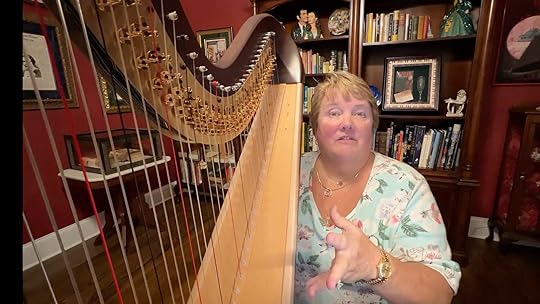
Due to PANA’s limits on Vimeo, I needed to edit the video so it lasted more than 7 minutes. This 6:50 Harp Explainer video is the result.
[This post contains video, click to play]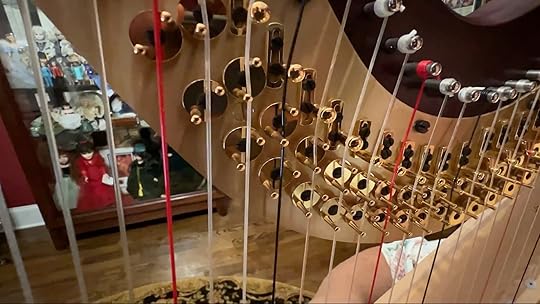
Out Takes
Of course, with any video project, some clips get left on the digital cutting room floor. I thought it would fun to include them here and pretend they are the DVD extras!
Starting in college, I turned away from music for a while. As shown in this :40 segment, someone special brought me back to it.
[This post contains video, click to play]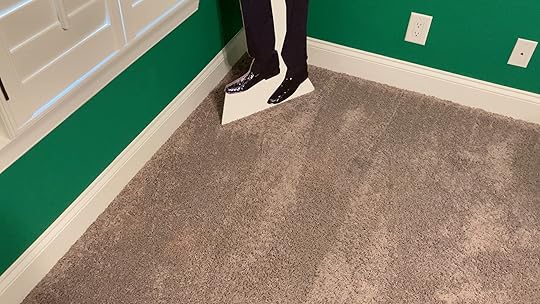
I forgot to mention in the video that I arranged “Weekend in New England” for every part in my high school band so I could play the oboe solo. Alas, we only played my masterpiece one time. I’ll never know if it was shelved because my teacher didn’t like Barry or my arrangement needed help.
This :11 clip shows the piano’s soundboard looks like a harp. In fact, the piano’s soundboard is called a harp.
[This post contains video, click to play]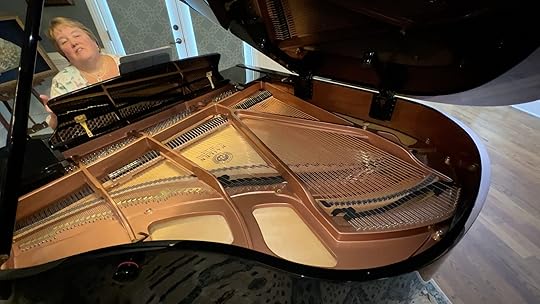
In this :56 clip, I show the harp’s note range on the piano keyboard.
[This post contains video, click to play]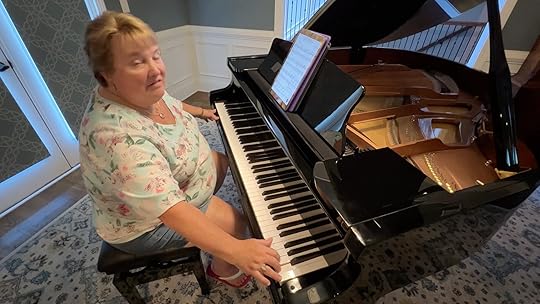
The pedals change the tone of the strings. These 2 clips demonstrate a C-flat and C natural scale are played on the same strings.
[This post contains video, click to play]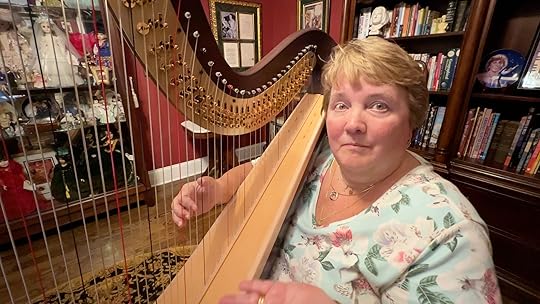
[This post contains video, click to play]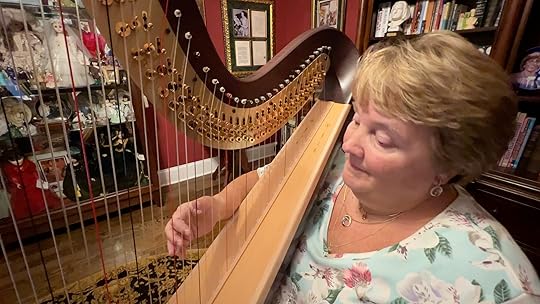
You may have noticed that I’m playing the harp with only 4 fingers on each hand, as I discuss in this :30 outtake.
[This post contains video, click to play]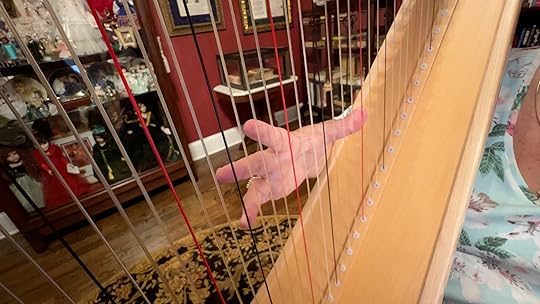
I had to cut The Sound of Music for time. Even if I could’ve included this 3:33 take of the whole song, I would have needed to trim the very end because ad libbing isn’t my strong suit. 
[This post contains video, click to play]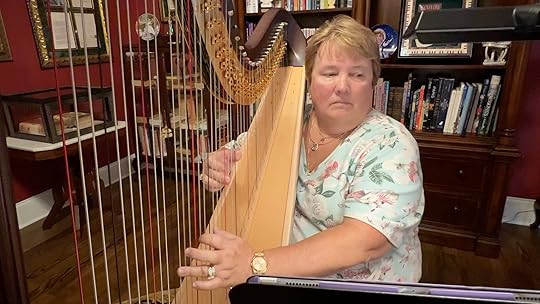
I love music so much that I listen to it all day in my office. As you’ll learn in this :59 piece, I’m NOT playing Barry Manilow! (shocker!)
[This post contains video, click to play]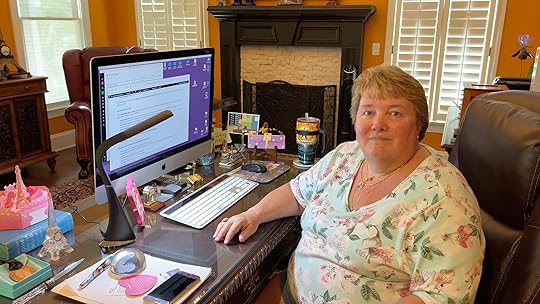
Resources
Naturally, I can’t write a blog article and not share some links with you!
Accessories
MisterStandman.com This talented master craftsman in Idaho custom-made the gorgeous wooden music stand you see in the videos with my flute. He also made a book stand for me with an Eiffel Tower in the frame, and I just received his stand with a harp in the center of the frame and finished beautifully to match my harp. I love the Victorian Lyre pattern, but he has many other designs. Click on the thumbnails below to see the full-size images.


 PageFlip Butterfly foot pedal This wonderful Bluetooth device allows you to turn your digital pages with your foot! You can move forward or backward through the piece. It works great when I play my flute or piccolo. When I play my harp, I may need to make a pedal change on the harp, so I’ll swipe the page with my hand.
Vekkia Music Stand Light
This clip-on light has 19 LEDs and 9 levels of brightness.
PageFlip Butterfly foot pedal This wonderful Bluetooth device allows you to turn your digital pages with your foot! You can move forward or backward through the piece. It works great when I play my flute or piccolo. When I play my harp, I may need to make a pedal change on the harp, so I’ll swipe the page with my hand.
Vekkia Music Stand Light
This clip-on light has 19 LEDs and 9 levels of brightness.Apps/Skills
Alexis Skill for SiriusXM When we moved to this house, I was thrilled to discover that it is wired for sound. We connected an Amazon Echo Dot to the control center. With this skill, I can summon Alexa to start playing SiriusXM. forScore This iOS-only app is well worth the $19.99 cost! I store my music for all my instruments in it and play using my iPad. I can annotate the music, which is extremely helpful as I adapt piano music for my harp.Music sites I use
FirstFlute.com This is a membership site where Sir James Galway teaches a series of video lessons. Imslp.com You can download public domain music here. Musicnotes.com You can purchase all genres of sheet music. It also has an app that plays the songs with adjustable speeds, so you can listen to understand how it should be played and/or play along with it. SiriusXM Escape Channel Playlist Since I listen to this channel all day outside the booth, I often want to know the title or artist of a song. This site not only gives me that info, but it shows all the times the song was recently played. Storyblocks.com I subscribe to this site so I can download royalty-free music to play underneath audiobook credits and as the soundtrack for my videos . I also download images and videos that I use in my articles and videos. If you find something you like, go ahead and download it. I’ve discovered that some things get removed over time.My articles with a musical theme
Resonance between harp and voice-over The Still Small VoiceMy harp videos (same videos in both places)
My Instagram feedOn this site’s Videos page
The post My Life as a Musician appeared first on Karen Commins.
May 26, 2022
Public Domain Narration Headquarters
When the obstacle in your way seems to have stopped you in your tracks,
it’s not a failure.
It’s part of what’s calling forth the necessary change
so you can move through, around, over, or under whatever is on your path to success.
— Christian Sørensen
This quote applies to my relationship to public domain books,
Although I started narrating audiobooks in 2002, it wasn’t until ACX launched in 2011 that I really got a foothold in the industry. Prior to that point, the market didn’t exist for a narrator who lived in Atlanta. You either had to be in New York or LA; otherwise, producers didn’t want to talk to you. With ACX, all of the rest of us could have a voice in audiobooks, too.
I soon burned out doing ACX projects since most of them were royalty share books where the rights holder was not promoting the audiobook. (Shameless plug: If you’re interested, I explain how to pick good ACX titles in my webinar Put Yourself in the ACX Drivers Seat, available on my Shop page.)
At the same time, I wasn’t getting traction with publishers. I decided to start recording more public domain books.
Public domain (PD) books are those where the copyright has expired. They belong to all of us, and anybody can do anything they want to with a book that’s in the public domain.
Over time, I’ve kind of become what I think of as the Public Domain Whisperer . I regularly search Hathitrust.org for interesting PD books. I often find a book that I think would be a good one for another narrator to do, so I send the link and the suggestion to them.
. I regularly search Hathitrust.org for interesting PD books. I often find a book that I think would be a good one for another narrator to do, so I send the link and the suggestion to them.
I’ve been gratified by the enthusiastic and excited responses to my finds. One experienced and award-winning narrator told me I had set them on a new path, and they’ve won a number of awards for their PD productions!
 This gorgeous old building is the former Morioka Bank Head Office in Morioka – Iwate, Japan. I found the picture on Wikimedia Commons, where the photographer Daderot generously released it to the public domain.
This gorgeous old building is the former Morioka Bank Head Office in Morioka – Iwate, Japan. I found the picture on Wikimedia Commons, where the photographer Daderot generously released it to the public domain.This article will be my Public Domain Narration Headquarters. I’ll start with ten reasons why I love, love, LOVE recording and publishing public domain books. Plus, check out the resources list below as well as the comments, where I answer your questions!
10. You’ll find an abundance of books that are ready for you to do.Right this minute, everything in the US published in 1926 and earlier is in the public domain. The copyrights have all expired.
Everything from 1927 to 1963 could be in the public domain, and the majority of them are. The copyrights had to be renewed during those years, and most people didn’t renew them. You must research a book’s copyright status to determine if the copyright was renewed. You’ll find info about research in the Resources section below.
Every year, new books come into the public domain!
On 1 January 2023, everything published in the United States in 1927 becomes public domain. What does that include? Well, the last of the Sherlock Holmes stories was published in 1927, so ALL of the Sherlock Holmes stories would be P.D. Other books from 1927 are the first three Hardy Boys mysteries, The Treasure of the Sierra Madre and books by Willa Cather, Virginia Woolf and Mary Roberts Rinehart. These and many more books will be public domain on January 1st.
If a book was published in 1927, you can start recording it today and be ready to publish it on New Year’s Day. You may find the early bird gets the worm.
9. You have complete creative control and freedom.You can change words. You can add or remove words. You can combine texts. In short, you can do anything you want to with a public domain book and are only limited by your creativity and imagination. I know people who have combined fairy tales or short stories (by theme or author) together to create a new compilation.
In a similar vein, one of my favorite projects of all time was one where I actually mashed up two public domain texts. Let me tell you the story to give you an idea of something you can do.
In 1889, Elizabeth Cochrane was a journalist for the NY World paper owned by Joseph Pulitzer. Her byline was Nellie Bly. As a publicity stunt for the paper, Nellie Bly challenged the feat set by fictional character Phileas Fogg to go around the world in 80 days. She was in New York and traveled east to London. She boarded a ship in mid-November, when the northern hemisphere was growing colder and losing daylight each day.
Meanwhile, Cosmopolitan, a rival magazine, didn’t want Nellie to get all the attention. So Cosmopolitan sent their reporter Elizabeth Bisland on a train that same day going west to San Francisco.
Nellie was trying to beat Phileas Fogg’s time, and Elizabeth wanted to beat Nellie! Nellie didn’t even know about Elizabeth’s trip.
They each wrote stories for their publication during their trips and later compiled their adventures in a book. Nellie’s book was published in 1890, and Elizabeth’s book appeared in 1891.
I mashed up their texts and put both women on the same timeline, which was so thrilling and exciting that I could barely stop to eat or sleep! I hired Melissa Reizian Frank to do a dual narration with me. In 2015, I published Bly vs Bisland: Beating Phileas Fogg in a Race Around the World in conjunction with the 125th anniversary of the end of the race. I love that whole project and still get chills thinking about it!
8. Public domain books don’t have any kind of external production deadlines.
If an idea sparks for you but you can’t work on it now, it will still be available when you have time for it. Be aware, though, why ideas love speed. Also, as another side note to that article, the Bly vs Bisland mash-up was an idea that woke me up!
Last year, another mash-up idea came to me. I’m slowly developing it in between narrating for publishers and continuing my self-publishing with ready-made PD books, as well as my continuous work on NarratorsRoadmap.com. A good PD book perfectly fills holes in my schedule!
7. Public domain books are usually extremely well edited, and they have very few typos.I particularly appreciated this aspect after narrating some contemporary manuscripts that weren’t quite up to that standard.
6. With PD books, I can record in genres that I love or in those where I’d like to work, all a low pressure setting.Nobody’s waiting on this recording or looking to see what I’m doing. I can try something new, which in turn gives me something else to share with people on social media and in my marketing.
I devour biographies for pleasure reading, so you can imagine my excitement to find Diane Disney Miller’s The Story of Walt Disney from 1957. The copyright was not renewed, and she later said she didn’t really write it. It’s Walt’s story as written by Pete Martin. It’s as close to Walt’s memoir as there ever was. I recorded it and was thrilled to publish it on the 110th anniversary of Walt Disney’s birthday.
5. When I’m self publishing, I’m always working and improving my narration skills.
Language styles change over time. I seem to pick PD books with very complex sentence structures. With every book I do, I look for ways to present the material naturally in a way that aids listener understanding.
As part of APAC this year, I was able to have a short meeting with a producer. Their first question was, “Tell me what you’ve been doing lately.” I replied that I had recently completed a true crime book and a couple of biographies. I didn’t distinguish that the true crime book was for a publisher and the 2 biographies were self-published public domain books. It all counts!
4. You can still record a PD book even if there are other audio editions of the book available.The beauty of public domain texts is that they belong to all of us! If it’s a popular book like The Wonderful Wizard of Oz, you may discover other audio editions available, sometimes MANY other productions. Nothing can stop you from recording another one! Your interpretation is going to be different than anyone else, and you’re making art that you’re proud of.
Current events or a movie tie-in can generate interest in an audiobook, for instance the news story behind this vague tweet where I went looking for a PD book. In 1915, explorer Ernest Shackleton sailed his ship Endurance to Antarctica. It got stuck in the ice and sunk. Over a century later, the ship was discovered. The History Channel showed a fascinating documentary about it in March.
My search for related books revealed Shackleton wrote about it in South. Several audio versions of it had been done, but I would happily record that book if I were a British man. He wrote another book about a different exploration that’s not on Audible. I also found a fabulous biography about him that’s not in audio.
3. I can submit my work for review.AudioFile Magazine reviewed one of my public domain books and has reviewed many from other narrators.
2. I can submit my work for awards.I entered So Big by Edna Ferber in the Independent Audiobook Awards and was thrilled when it became a finalist in the Classics category.
1. I keep all of the royalties.I have to tell you, passive income from public domain audiobooks every month is the gift that keeps on giving!
Like a royalty share book, you’re not guaranteed a book will sell, much less be a hit. It may take a while for it to earn out. It may never earn out. It’s always a risk.
But one PD book that does really well can make up for all the ones that aren’t selling as well! The more public domain books I record and publish, the more I want to do, and the more excited I am about my work.
Other resources on this topic:
As I continue to create content related to public domain books, I’ll update the list below.
Starting Point
My Create Your Own Path video course is available to all paid members of NarratorsRoadmap.com . I discuss how to research public domain books, explain publishing considerations and distributor options, and include a long list of relevant resources not found here. For instance, I’ve curated collections of books on Hathitrust.org that narrators might choose to perform in the categories of: 1925 publications, 1926 publications, baseball, biographies/memoirs, diaries and letters, fiction, history and crime, Theodore Roosevelt, and Will Rogers. As a special enticement to join, you’ll find a discount on my Shop page in the “Rent My Brain” section.I’ve long advocated creating your own work. In addition to my 10 points above, you might read my articles Reasons to Create Your Own Stuff part 1 and part 2 . The profound Eckhart Tolle quote that I highlighted in part 2 has proven true for me.Since public domain books have much in common with royalty share books, the 5 reasons I listed in this article to do royalty share books apply to public domain books. When I wrote I’d do a royalty share over a public domain title, I wasn’t commercially publishing PD books. Now, I’d publish a PD book before I’d narrate and produce an RS book!I wrote this article to help narrators understand some copyright basics.These 2 articles are overflowing with links you’ll use to research rights holders and copyright dates: Links to Help Narrators Research Rights Holders to Books When the Author is 6 Feet UnderAmazon Edition
If you distribute your audiobook through ACX or Findaway, which uses ACX to distribute to Audible, you must start the process with an Amazon edition. Keep in mind that ACX is owned by Audible, which is owned by Amazon; as a result, everything in ACX is part of the Amazon ecosystem. This requirement for an Amazon edition is ONLY true of ACX. Other distributors do not have this stipulation. This article describes what I did to publish a Kindle edition. Be sure to read all of the extensive comments to get the workaround and more tips!Cover Art and/or Supplemental PDF of Images
I detailed my experiences in finding and selecting art for the Kindle version of Fanny Herself: A Passionate Instinct in this article . At the time, I had change the title to differentiate it per Kindle Publishing rules. If I were publishing it today, I’d leave the original title as is so that it would get displayed with the other editions on Amazon. This article examines whether you can legally re-use the images in a public domain book for your cover art or supplemental PDF.When using art depicting a real person, you not only have to research the copyright for the image but also whether you would violate their Right of Publicity as detailed in this article .You can use public domain art for your cover. My article Tour of Sites with Public Domain Art links to a bunch of repositories with comments about the images available in each.Promo Videos
You might find inspiring ideas in my articles Creating promo videos with public domain components part 1 and part 2 .The post Public Domain Narration Headquarters appeared first on Karen Commins.
April 22, 2022
Feather, Phone, and Fun
I’ve been receiving Mike Dooley’s daily Notes from the Universe for years. I’ve taken some of his courses, and I enjoy how he presents material on the Law of Attraction.
I signed up for his Magical Mystery Manifesting Adventure, which began today. Each day in the 21 days, he and co-presenter Pam Grout will send an email with a secret mission of something to manifest.
When I read today’s assignment of a feather, I thought of a peacock feather. If you read my last blog post or saw this tweet or this Facebook post of a my picture of a real peacock, you might think I have a fondness for peacocks! I thought a feather would be unusual to find.
Drew and I were on our way to pick up something we had ordered. It was Friday lunchtime traffic on a major road that is always congested.
I saw we were about to drive by a flea market I like but haven’t shopped in for a year or more. It’s one of those places that used to be a grocery store but is now filled with several hundred vendors who sell everything from baseball cards to crystal chandeliers. Some of the booths contain so much merchandise that you can’t see everything and have difficulty even walking in. I fear one wrong move will send some precarious piece crashing to the floor.
I said I’d like to stop there. His first inclination was that it was too difficult to turn left out of its parking lot to get to the store. I said I had no business at the flea market and wasn’t looking for anything in particular. We should go on to our destination.
As we turned on the street by the flea market, I commented that we could’ve turned right out of the parking lot and gone only a little bit out of the way to the store. He offered to turn around, but I stubbornly said to keep going where we were headed.
He said again he could turn around because he knew I’d want to go to the flea market.
Reader, that wonderful man I married DID turn around, drove back to the flea market, and parked in front of the door.
I usually like to walk up and down every aisle, taking a quick look left and right to see everything crammed in all the stalls. I skipped a couple of aisles to avoid other shoppers and thought about leaving and returning some weekday when fewer people would be there.
I had not told Drew about the feather assignment.
We’d been through about 80% of the flea market when there, right at the aisle, was not 1 peacock feather, or 2….but about a dozen of them!
I then let Drew know the goal of today’s mission. He pointed out some MORE peacock feathers in 2 other places in that booth! I not only got my peacock feather, but in the abundance of the Universe, I was able to pick the one that seemed the most vivid!
The critical voice inside is saying, “The chances of finding feathers, even peacock feathers, at a flea market are pretty good.”
That’s true. Beyond my peacock feather, I saw 5 feathered boas in different colors and all manner of bird pictures and figurines.
If I only manifested the peacock feather, I probably wouldn’t have posted this story.
We walked up the next aisle, and I saw it — the antique golden oak wall telephone I have wanted for decades!! Of course, I’ve seen them many times and could have bought one long before now.
Today, I said to myself, “What are you waiting for? BUY IT!” I’m so excited to FINALLY fulfill this long-held dream!
But there was one more very unexpected thing that came home with us from the flea market.
Hanging on the back wall, almost hidden behind a display cabinet and flower arrangements on the table, was an old, cast-iron sign that’s about 2/3 the size of a license plate and about 25 times heavier. It reads:
SOUTHERN RAILWAY
QUIET PLEASEAVOID ANNOYANCE TO RESIDENTS
KEEP YOUR ENGINE QUIET AND
TAKE CARE TO AVOID SMOKE
AND STEAM
It caught my attention and made me laugh as we walked by it. That’s good advice for all of us! I decided I needed this sign hanging outside my recording studio next to my Hush sculpture. It will make me smile every time I walk in there!
After today’s marvelous manifesting success, I’m really looking forward to seeing what happens in the remaining 20 days in the course!
Oh, and we did turn right out of the parking lot and got to the store in about the same amount of time as our original route would have required!
By the way, what do you think Drew found on our patio this afternoon?
A FEATHER!
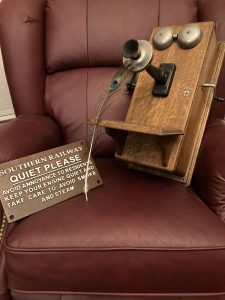
The post Feather, Phone, and Fun appeared first on Karen Commins.
January 3, 2022
Just Pick One and Do It
On 1 February 2018, I started working on a 13″ x 18″ Glorafilia Tiffany peacock needlepoint kit. While it isn’t finished (yet!), it serves as inspiration and motivation for both my hobbies and career choices.
 The picture on the Glorafilia Tiffany Peacock needlepoint kit. The finish line is in sight!
The picture on the Glorafilia Tiffany Peacock needlepoint kit. The finish line is in sight!I’ve done dozens of counted cross stitch pieces over several decades, but I’d completed just one needlepoint kit, an iris pillow, before starting this one. The pillow only called for the basic tent stitch, where the peacock required several decorative stitches.
After I completed the easy background tent stitches at the top, I let the canvas sit for months at a stretch (pun intended) because I felt overwhelmed by all the color changes, especially in the peacock’s tail. Each time I’d pick it up, I’d spend time being indecisive about which color to start with. Sometimes it would just look like too much left to do on an overly ambitious design, so I wouldn’t do anything on it.
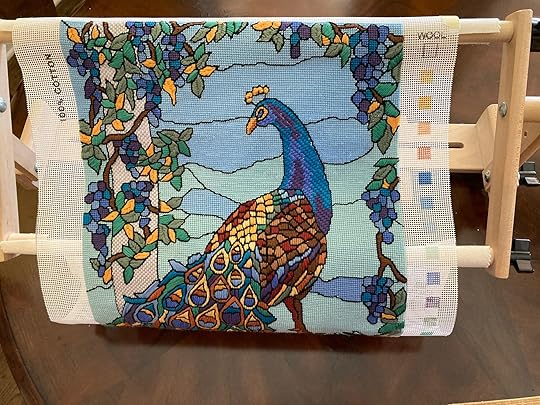
As if the design wasn’t intricate enough, I decided to make some of the leaves look more lifelike with a vein. I don’t think a single one turned out the way I wanted on my first attempt to stitch it.
Even though the satin stitches in the tail were longer and seemingly quicker to do, the tail feathers were much more complicated than I expected. I found myself unstitching and restitching multiple times on almost every color change because the stitches didn’t lie flat or fully cover the canvas. If each stitch was meant to be the “hair” (which I’ve learned through Google is the “barb”) of a feather, I made stitching errors that made the peacock look like my schnauzer had nipped at him. I’m still not completely happy with some of my stitches, but I don’t want to make this project into life’s work!
I felt a tremendous sense of accomplishment on Sunday night when I finally finished filling in the bottom of the peacock’s tail! I still need to outline parts of it and stitch most of the bottom right corner. I’m confident I’ll finish the piece (and hopefully get it to a frame shop) before its 4th anniversary rolls around next month.
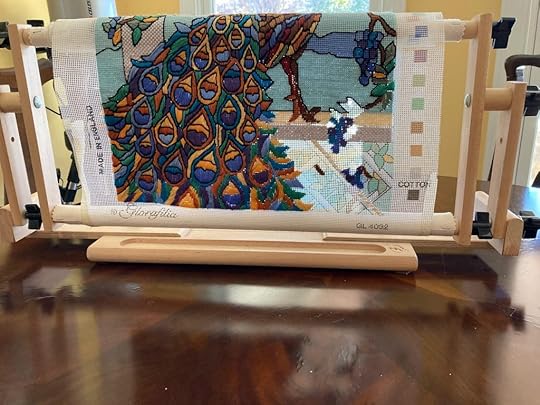
I didn’t feel overwhelmed with building my Lego sets (bookshop and typewriter) because I had step-by-step instructions, though some were confusing as you have no text and must interpret diagrams. I did make a couple of mistakes with adding a brick on the wrong side or in the wrong place. Fortunately, I’m married to my own personal Lego guru. Drew was able to figure out and fix my errors, saving me from undoing and redoing everything.
With my current paint-by-number canvas of Van Gogh’s Irises, the somewhat paralyzing indecisiveness over color choice is back in full force.
In all 3 of these hobbies, instructions generally are clear, and the outcome is known before I start.
In my career choices, I have no instructions or known outcome. It’s easy to have analysis paralysis when considering conflicting choices, especially since spending time on one thing takes time needed for something else. For example:
Should I research a public domain book for possible narration, and if so, which one?Should I write an article today? If I do, should it be something for my blog or the NarratorsRoadmap.com Knowledge Base?Should I create a video?I’m currently adding listings to my exclusive casting directory for NarratorsRoadmap.com 6-month and yearly members. Which company should I add next? Should I pick a production company or a publisher?The needlepoint peacock has shown me again that if I would just do a little bit each day, the whole thing starts to come together and reveal itself over time.
I know how to prioritize my tasks and ensure that my work for others is done ahead of the deadline. I adhere to schedules for my personal and NarratorsRoadmap.com member newsletters.
However, many things on my to-do list are self-imposed and have equal priority, like the colors in a needlepoint or paint-by-numbers kit. In those cases, it doesn’t matter which one I pick.
What does matter is TAKING CONSISTENT ACTION.
By not worrying about making a mistake, any action will move me forward in some way. I learn things that don’t turn out quite the way I envisioned and find better ways to do them. The outcomes tend to be far more beneficial and beautiful than I could have imagined!
The post Just Pick One and Do It appeared first on Karen Commins.

